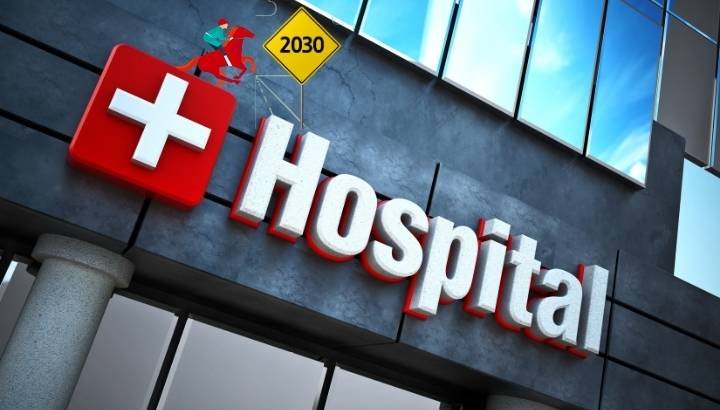India’s hospital industry is rising at a rapid pace. With rising demand for better healthcare, new technologies, medical tourism in India, and government support, this sector is experiencing a major boom in the market.
As per the recent report from IBEF (India Brand Equity Foundation) and industry experts, the India hospital market growth 2030 is predicted to reach a massive ₹22.5 lakh crore by 2030, rising at an annual rate (CAGR) of around 12% from 2022.
Let’s dive in and discuss what’s driving this growth, what trends are shaping the future, and what it means for patients, investors, and the healthcare industry.
Why is the India Hospital Industry Booming?
The India hospital market growth 2030 is happening at a rapid pace because of these important factors:
1. Growing Demand for Healthcare
Because India now has the world’s largest population, which is over 1.4 billion people. As cities are growing and the middle class grows, more people need access to good hospital facilities and healthcare.
Diseases like diabetes, high blood pressure, and heart problems keep on increasing, increasing the need for specialist care and modern hospital infrastructure.
2. Supportive Government Policies
Government schemes like Ayushman Bharat focus on giving affordable healthcare to more than 50 crore Indians. The government also plans to increase healthcare spending to 2.5% of the total GDP by 2025.
This push is opening opportunities for hospital networks, private companies, and global investors to build and keep expanding.
3. Expansion of Private Hospitals
Private hospital networks like Apollo, Fortis, Max Healthcare, and Narayana Health are growing into Tier 2 and Tier 3 cities. This helps close the difference between rural and urban healthcare and improves reach for smaller towns.
4. Rise in Medical Tourism
Because most of the treatments in India are affordable, doctors are skilled, and hospitals are well-equipped, that’s why India is becoming a top destination for medical tourism.
In FY23, medical tourism in India was priced at $7.4 billion, and it is expected to reach $13 billion by 2026, as per FICCI and the Ministry of Tourism.
India Hospital Market Size Forecast: Key Numbers
Current Market Size: ₹8 to ₹10 lakh crore as per 2022-23.
Expected Market Size: ₹22.5 lakh crore by 2030.
Growth Rate: 12% to 13% CAGR based on IBEF and Frost & Sullivan reports.
This means that the India hospital market growth 2030 will rise more than double in just a few years.
Investment Trends Driving the Growth
1. More Hospitals and Beds
Many companies are now investing in super-speciality and multi-speciality hospitals, mainly in regions that shortage good healthcare facilities. India plans to add over 1.5 million hospital beds by 2030 to meet this demand.
For now, India’s hospital beds per capita are lower than the global average set by the WHO.
2. Digital Healthcare and Health-Tech
Modern technologies like telemedicine, AI-based diagnostics, robotic surgery, and smart hospital management are changing the way hospitals work.
Health tech startups like Practo, 1mg, and Portea are collaborating with hospitals to reach more people online.
3. Mergers and Acquisitions
Private equity firms and global investors are buying shares in Indian hospitals. For example, Blackstone invested in CARE Hospital, and Temasek took a share in Manipal Hospital.
These deals really help hospitals to grow even faster and upgrade with technology.
Key Healthcare Trends in India
Daycare Surgeries & Short-Stay Treatments: Because of better technologies, many methods now need just a day at the hospital.
Preventive Healthcare: More hospitals are now offering regular check-ups and wellness packages to prevent diseases related to lifestyle.
Green & Eco-Friendly Hospitals: New hospitals are now focusing more on sustainable designs, using solar energy, and efficient waste management.
Personalized Medicine: Hospitals are now using AI and genetic testing to provide treatments personalized to individual patients.
AYUSH Integration: Many hospitals now join modern medicine with Ayurveda, Yoga, and other traditional therapies for a more complete approach.
Challenges India’s Hospital Industry Still Faces
Even though India’s hospital industry is rising, some challenges remain:
Shortage of Medical Staff: There is a shortage of trained doctors and nurses, mainly in rural areas.
High Cost of Equipment: Developed or high-level medical tools are expensive, which makes it tough for small hospitals to upgrade.
Tough Regulation: Hospitals must meet many conformity and approval rules.
Affordability: Even with the government schemes, some treatments are still very costly for poor and even middle-class families.
Solving these issues is really important to make sure that growth is fair, widespread, and long-lasting.
What This Means for Investors and Patients
For investors from both India and abroad, this is a hopeful time. There are huge investment options in hospital networks, digital healthcare, and infrastructure projects, mainly in Tier 2 and Tier 3 cities.
For patients, this means better access, shorter travel time, more advanced technologies, and affordable medical care.
The Indian hospital market is evolving very fast, and this growth can benefit everyone, if it is managed with care and responsibility.
Conclusion
The Indian hospital market is at a turning point, with the hospital market size expected to touch ₹22.5 lakh crore by 2030. There is no confusion this sector is on the rise.
The focus now should be on making healthcare not just bigger, but also better accessible, affordable, and ready for the future.
FAQs
What is the projected market size of India’s hospital industry by 2030?
By 2030, it is expected to reach ₹22.5 lakh crore.
What factors are driving this growth?
Factors like higher demand for healthcare, government schemes, private hospital expansion, medical tourism, and digital tech.
Which cities are attracting the most hospital investments?
Tier 2 and Tier 3 cities like Lucknow, Indore, and Coimbatore are seeing some solid investments.
How big is India’s medical tourism sector?
In FY23, it was $7.4 billion and is expected to grow to $13 billion by 2026.
What are the biggest challenges?
Some biggest challenges are staff shortage, high tech costs, tough regulations, and making healthcare affordable for all.

